THE R&D
UNNATURAL INSTABILITY:
All Shoe Soles Have a Very Dangerous But Correctible Stability Defect
The previously undiscovered dangerous instability of shoe soles likely causes many or most of the serious falls that resulted in $129 billion in medical costs caused by 6,460,000 ER visits, 1,400,000 hospitalizations, and 40,000 fall deaths in 2019 in the U.S. alone. To put that level of fatalities in context, 43,000 traffic deaths occurred last year in the U.S.
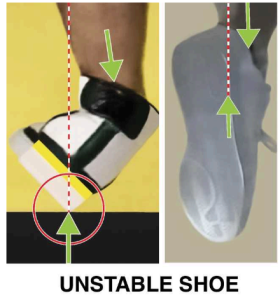
Many or most of these serious falls are avoidable because the necessary structural corrections in a prototype sole design are proven in initial testing and available for free use in the public domain.
The testing prototype soles are far more stable, like the barefoot, and uniquely comfortable as well.
A shoe sole is artificially unstable when tilted outward as far as the subtalar joint naturally allows it to go, into the typical lateral ankle spraining position. Like a seesaw, the entire ankle joint and the bodyweight force transmitted through it pivot on a knife-edge (the thin white streak) of a shoe sole that contacts the ground. The opposing forces are out of alignment, creating an unnaturally powerful destabilizing torque on the tilted ankle. The tilted ankle is supported by the wearer’s ligaments and muscle tendons alone.
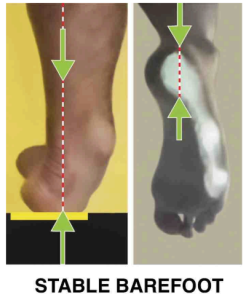 In contrast, a barefoot is naturally stable when rolled outward into the same ankle spraining position, with opposing forces inline and directly supported by leg, ankle, and heel bones, all interlocked in perfect natural alignment. The bare sole enjoys a wide base of support, especially under the calcaneus or heel bone, as well as under the base and head of the fifth metatarsal bone (all three bones sites indicated by the large white areas of support).
In contrast, a barefoot is naturally stable when rolled outward into the same ankle spraining position, with opposing forces inline and directly supported by leg, ankle, and heel bones, all interlocked in perfect natural alignment. The bare sole enjoys a wide base of support, especially under the calcaneus or heel bone, as well as under the base and head of the fifth metatarsal bone (all three bones sites indicated by the large white areas of support). NATURALLY WIDE FOOTPRINT
The artificial lack of stability in shoe soles is due to the foot sole simply rolling over the outside edge of the upper surface of the shoe sole uncontrollably, which causes lateral ankle sprains, breaks, and falls with serious injuries. When the wearer’s foot rolls as far as the subtalar joint permits, as shown in Maximum Supination Footprint (below, in yellow, superimposed on an upper surface outline of a typical shoe sole), most of the side of the load-bearing foot sole is unsupported by the too narrow shoe sole.
 The same kind of mismatch exists between shoe sole and the Maximum Pronation Footprint (also in yellow) of the wearer’s foot. The foot tends to roll onto or over the inside (medial) edge of the shoe sole’s upper surface,
unnaturally destabilizing the shoe sole by causing an inward tilt. When the rolling motion is extreme, uncontrollably tilting the shoe sole inward, the resulting gross instability provides an explanation for the ongoing epidemic of acute knee injuries, particularly among female athletes, including anterior cruciate ligament (ACL) ruptures and tears.
The same kind of mismatch exists between shoe sole and the Maximum Pronation Footprint (also in yellow) of the wearer’s foot. The foot tends to roll onto or over the inside (medial) edge of the shoe sole’s upper surface,
unnaturally destabilizing the shoe sole by causing an inward tilt. When the rolling motion is extreme, uncontrollably tilting the shoe sole inward, the resulting gross instability provides an explanation for the ongoing epidemic of acute knee injuries, particularly among female athletes, including anterior cruciate ligament (ACL) ruptures and tears. 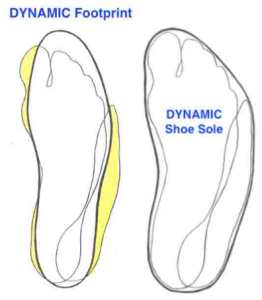 Controlled by the subtalar joint, the full range of normal motion of the foot sole during the extreme motion that often occurs in athletics and running extends the sides (in yellow) of the Dynamic Footprint far outside the sides of structural support provided by a conventional shoe sole.
To be as stable as the barefoot, the sides of a Dynamic Shoe Sole must extend as far as the foot’s dynamic footprint to provide naturally safe locomotion. In addition, instead of being flat, the extra width of the Dynamic Shoe Sole must be curved up around the sides of the rounded sole of the foot to avoid creating unnatural destabilizing levers.
Controlled by the subtalar joint, the full range of normal motion of the foot sole during the extreme motion that often occurs in athletics and running extends the sides (in yellow) of the Dynamic Footprint far outside the sides of structural support provided by a conventional shoe sole.
To be as stable as the barefoot, the sides of a Dynamic Shoe Sole must extend as far as the foot’s dynamic footprint to provide naturally safe locomotion. In addition, instead of being flat, the extra width of the Dynamic Shoe Sole must be curved up around the sides of the rounded sole of the foot to avoid creating unnatural destabilizing levers.
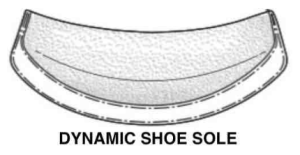 The shoe sole must also be sufficiently flexible to flatten under a bodyweight load, as does the rounded barefoot sole, particularly the heel. Finally, the dynamic shoe sole must have a uniform thickness in frontal plane cross-sections to maintain natural barefoot lateral stability, as seen in the example heel cross-section.
The shoe sole must also be sufficiently flexible to flatten under a bodyweight load, as does the rounded barefoot sole, particularly the heel. Finally, the dynamic shoe sole must have a uniform thickness in frontal plane cross-sections to maintain natural barefoot lateral stability, as seen in the example heel cross-section. THE PROTOTYPES
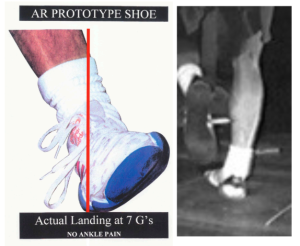 This is not a theoretical design. An Anatomic Research Prototype shoe incorporating these features was constructed in 1993 and tested at the biomechanics lab at U. Mass at Amherst. Its performance was unprecedented, proving capable of stable single foot landings in the maximum supination position typical of lateral ankle sprains at peak forces as high as 4 to 7 G’s without ankle any ankle sprains or even pain.
That unique lab test was obviously impossible to perform in conventional shoes due to very high risk of serious injury, but a similar standing test indicated an ankle pain threshold in conventional shoes of as little as 0.25 G in the maximum supination ankle spraining position.
This is not a theoretical design. An Anatomic Research Prototype shoe incorporating these features was constructed in 1993 and tested at the biomechanics lab at U. Mass at Amherst. Its performance was unprecedented, proving capable of stable single foot landings in the maximum supination position typical of lateral ankle sprains at peak forces as high as 4 to 7 G’s without ankle any ankle sprains or even pain.
That unique lab test was obviously impossible to perform in conventional shoes due to very high risk of serious injury, but a similar standing test indicated an ankle pain threshold in conventional shoes of as little as 0.25 G in the maximum supination ankle spraining position.
 The patented technology was exclusively licensed to Adidas from 1994 to 2003, but its pioneering commercial development then did not reach the full potential demonstrated by the AR Prototype. However, the required industry technologies have fully matured since then. And independent development by FRAMPTON ELLIS at Anatomic Research has also continued since then, as shown in this new corrected and naturally stable baresole™ of the experimental test prototype FRAMPTON ELLIS™ slide.
The patented technology was exclusively licensed to Adidas from 1994 to 2003, but its pioneering commercial development then did not reach the full potential demonstrated by the AR Prototype. However, the required industry technologies have fully matured since then. And independent development by FRAMPTON ELLIS at Anatomic Research has also continued since then, as shown in this new corrected and naturally stable baresole™ of the experimental test prototype FRAMPTON ELLIS™ slide. As a public service, samples of the corrected experimental test prototype FRAMPTON ELLIS™ slide will now be made available by Anatomic Research to shoe companies so they can use the slide as a general model to directly copy and test the slide’s simple basic baresole™ structure to develop safe commercial products.
FUTURE PROTOTYPES
 A corrected experimental test athletic shoe, shown here, also designed and developed by FRAMPTON ELLIS at Anatomic. Its baresole™ has a more complex upper, insole, midsole and outsole combination. When ready, it will also be made available as an experimental test prototype to serve as an initial model of stability and comfort for the athletic footwear industry to copy, test, and improve.
A simple example of the use of the corrected stability design in potential redesigns is the classic basketball shoe, the Converse All Star. It has been modified by a Photoshop simulated integration of the baresole™ structure of the FRAMPTON ELLIS™ slide into the classic All Star shoe upper.
A corrected experimental test athletic shoe, shown here, also designed and developed by FRAMPTON ELLIS at Anatomic. Its baresole™ has a more complex upper, insole, midsole and outsole combination. When ready, it will also be made available as an experimental test prototype to serve as an initial model of stability and comfort for the athletic footwear industry to copy, test, and improve.
A simple example of the use of the corrected stability design in potential redesigns is the classic basketball shoe, the Converse All Star. It has been modified by a Photoshop simulated integration of the baresole™ structure of the FRAMPTON ELLIS™ slide into the classic All Star shoe upper.  The result shows little change to the basic look of the classic shoe. The sole sides go from vertical to tilted out about 20°. The sole sides are less angled than the flared sides of soles of running shoes that were introduced in the 1970’s, but are now a part of a completely different internal sole structure, one that is finally stable after two thousand years of instability.
The result shows little change to the basic look of the classic shoe. The sole sides go from vertical to tilted out about 20°. The sole sides are less angled than the flared sides of soles of running shoes that were introduced in the 1970’s, but are now a part of a completely different internal sole structure, one that is finally stable after two thousand years of instability. ANKLE SPRAINS AND FALLS
Ankle sprains are clearly unnatural and avoidable, but remain the most common cause of both athletic injuries and hospital ER visits. None of the sprains are preventable in conventional shoe soles, even when the best existing commercial shoe and ankle anti-sprain technologies are used.
 If there could be any doubt of that, this harsh reality is clearly demonstrated by superstar NBA 2014 MVP Stephen Curry, who is shown here wearing his signature performance basketball shoe and a state-of-the-art ankle brace on his nevertheless badly sprained right ankle.
Artificially unstable shoe soles cause unnatural ankle sprains and breaks, which also cause falls, often with serious injuries. The total annual U.S. medical cost of the accidental falls was about $129 billion, dwarfing the estimated total annual branded athletic footwear sales worldwide of about $83 billion.
Given the strikingly horrific stability defect clearly evident in existing sole design, a very reasonable conservative estimate is that half of those falls are caused by the obvious instability of footwear soles. If so, the roughly $65 billion in total annual U.S. medical costs of those avoidable falls each year more than doubles the annual total of U.S. branded athletic footwear sales of about $31 billion.
If there could be any doubt of that, this harsh reality is clearly demonstrated by superstar NBA 2014 MVP Stephen Curry, who is shown here wearing his signature performance basketball shoe and a state-of-the-art ankle brace on his nevertheless badly sprained right ankle.
Artificially unstable shoe soles cause unnatural ankle sprains and breaks, which also cause falls, often with serious injuries. The total annual U.S. medical cost of the accidental falls was about $129 billion, dwarfing the estimated total annual branded athletic footwear sales worldwide of about $83 billion.
Given the strikingly horrific stability defect clearly evident in existing sole design, a very reasonable conservative estimate is that half of those falls are caused by the obvious instability of footwear soles. If so, the roughly $65 billion in total annual U.S. medical costs of those avoidable falls each year more than doubles the annual total of U.S. branded athletic footwear sales of about $31 billion. Unmistakably, this is a serious national health crisis with a magnitude of death and economic damage that far exceeds the 9/11 attack in the U.S. And it reoccurs every year. Cumulatively, over the last two decades it totals almost as many deaths in the U.S. as caused by 4 the opioid crisis. In contrast to that crisis, this one has a simple solution that is proven and effective. Moreover, the relative financial cost of a one-time general design and manufacturing correction within the footwear industry of the design defect of shoe soles is, without question, tiny in comparison.
Moreover, the relatively small one-time financial cost to the footwear industry should be paid for easily within the industry by a likely substantial increase in sales and profits fed by increased consumer demand for footwear that is much safer and, a major bonus, also much more comfortable. It is a unique win-win solution for both industry and its consumers!
A QUICK & EASY FIX
Furthermore, as the quickest possible first step, there is a simple structural fix that at least noticeably reduces the effect of the instability defect of conventional shoe soles. It is a worthwhile increase in the stability that can be retrofitted with little expense almost immediately to existing conventional designs.
 This relatively quick and easy initial fix involves only a minor extension of the middle part of the lateral side of the shoe sole. The extension simply eliminates a conventional lateral indention between heel and forefoot – a previously unnoticed stability flaw. The addition of a straight-sided Midfoot Lateral Sole Extension (shown in red) is located where the mismatch (in yellow) is greatest between the narrow shoe sole and the much wider bare sole footprint in extreme supination, thereby substantially reducing an existing dangerous trigger of instability.
This relatively quick and easy initial fix involves only a minor extension of the middle part of the lateral side of the shoe sole. The extension simply eliminates a conventional lateral indention between heel and forefoot – a previously unnoticed stability flaw. The addition of a straight-sided Midfoot Lateral Sole Extension (shown in red) is located where the mismatch (in yellow) is greatest between the narrow shoe sole and the much wider bare sole footprint in extreme supination, thereby substantially reducing an existing dangerous trigger of instability.  Using the midfoot lateral sole extension can reduce the number and severity of lateral ankle sprains and falls during walking and standing, particularly among the elderly. It lowers injury incidence and severity for athletics to a much lesser, but still worthwhile degree.
In one example among many made and tested, a Nike Pegasus 38 was physically modified by adding a straight-sided midfoot lateral sole extension to produce a more stable Pegasus 38. As shown here (with touch-up assistance from Photoshop), the structural sole change would be almost invisible in such a modified Pegasus 38 that was made in actual factory production.
Using the midfoot lateral sole extension can reduce the number and severity of lateral ankle sprains and falls during walking and standing, particularly among the elderly. It lowers injury incidence and severity for athletics to a much lesser, but still worthwhile degree.
In one example among many made and tested, a Nike Pegasus 38 was physically modified by adding a straight-sided midfoot lateral sole extension to produce a more stable Pegasus 38. As shown here (with touch-up assistance from Photoshop), the structural sole change would be almost invisible in such a modified Pegasus 38 that was made in actual factory production. The instability triggered by the lateral indentation defect is greatest in the highly sculpted soles of many modern athletic shoes, but it also destabilizes old classics like the Converse All Star basketball sneaker. Both classic and new conventional shoe sole designs can be quickly redesigned with this simple fix to remove the dangerous trigger defect to provide a noticeably safer level of stability as soon as possible.
THE SIMPLE SCIENCE
The basic science presented here is so simple and the results so unequivocal that it is quite unprecedented in modern research. Valid modern scientific studies done in sophisticated labs with lots of expensive equipment usually can produce test results with only very small differences that often are not statistically meaningful and also are often very difficult to replicate. Moreover, the vast majority of studies are never replicated, so their actual validity is unverified.
It should also be noted here that there is no formal scientific or medical research that contradicts the research evidence presented here for the simple reason that there is no formal research whatsoever that examines the difference in extreme stability between shoe soles and barefoot soles. That enormous difference has been entirely overlooked, despite its now obvious relevance to ankle sprains and dangerous falls with thousands of deaths and billions in costs.
It’s easy to understand why it has been missed. Despite their carefully cultivated reputation for being high tech, the footwear companies do not do real research. They spend all of their R&D funding on the development of the deeply flawed but unexamined existing sole design. Even there, their total R&D funding is only 1/10 of the average R&D funding for all U.S. companies. And, of course, no private or Federal funding exists for truly basic research in footwear, generally, or soles in particular, the critical human structural support component.
In light of this, it seems difficult if not impossible even to conjecture what a reasonable counter argument might be to the now obvious evidence presented here on the basic defect in footwear soles. The only available defense is a plea to believe industry experts, not your own lying eyes. Or in this instance, don’t believe your own lying feet and shoes.
Instead, simply put, the irrefutable and easily reproducible evidence of the natural stability of the human ankle when barefoot absolutely proves that the well-known instability of the ankle in a shoe is entirely due to the shoe and not the ankle. The instability of all current shoes is therefore clearly due to the artificial defect in their shoe soles.
Consequently, there can be no reasonable defense of the status quo in footwear by its industry. No delay can be justified by footwear companies to immediately working with the greatest possible urgency to finally correcting the now obvious sole defect.
A MUCH GREATER MEDICAL CATASTROPHE, ALSO HIDDEN IN PLAIN SIGHT
As destructive and costly as is the instability defect of the structure of conventional shoe soles, the overlooked effects of a different but also unnatural shoe sole structure are far worse and vastly more harmful.
The modern human body has been severely deformed by the unnatural rearfoot elevation created by the ordinary everyday elevated shoe heel. Its pervasive effects on the human body appear to cause every year as many as 900,000 untimely deaths in the U.S. and roughly $1.4 trillion in avoidable medical costs – about a third of the total of U.S. medical care costs.
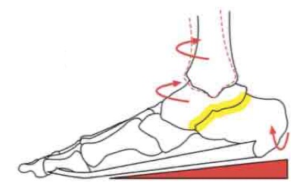 For the past several centuries, nearly all modern humans have worn athletic and other shoes with elevated heels. They unnaturally supinate the subtalar joint (located between ankle and heel bones). New research provides unusually reliable proof that during running the ankle joint is artificially tilted out 8° away from vertical and twisted out away from straight ahead by 18° during peak loads of 3 G’s. Both legs are therefore badly misaligned by ordinary shoe heels during the human body’s highest repetitive bodyweight loads.
For the past several centuries, nearly all modern humans have worn athletic and other shoes with elevated heels. They unnaturally supinate the subtalar joint (located between ankle and heel bones). New research provides unusually reliable proof that during running the ankle joint is artificially tilted out 8° away from vertical and twisted out away from straight ahead by 18° during peak loads of 3 G’s. Both legs are therefore badly misaligned by ordinary shoe heels during the human body’s highest repetitive bodyweight loads. Under the uncomplicated operation of well-established anatomical laws of Wolff and of Davis, the result over a lifetime is bilaterally asymmetrical malformation of all of the bone, joint, and other anatomical structures of the modern human body – from toe to head, including the brain. Wide individual variation in specific deformities is determined by personal factors like footwear use, genetics, biological sex, and the pure chance introduced by accidental injury.
The often incredibly extensive deformity of the human body begins in early childhood and increases throughout life, reaching its greatest effect in the elderly. The artificial deformity has the potential to damage any structure of the body or degrade any function and to worsen any disease or injury, creating thereby an abnormally longer and higher level of pain and suffering.
REMARKABLY RELIABLE PROOF
Of course, this constitutes a public health catastrophe of such an extraordinary magnitude as to be totally unbelievable on its face. However, confirmation of its reality is provided by remarkably trustworthy new evidence. The evidence is based on a revolutionary new gold standard of joint motion measurement, one that reliably overturns the biomechanical results of all prior research on pronation during running. That prior research showed significant pronation of the subtalar joint at peak load during running, but those results were false and misleading. The new research unequivocally proves the opposite, that the actual position of the subtalar joint is always substantially in supination throughout the load-bearing stance phase of running.
Overturning at least a half century of running research, the correct new data indicates that the long-observed pronation in the subtalar joint during running is instead only a relative reduction in a much greater level of supination that remains throughout the stance phase of running. The new data shows that the 12º inversion or supination of the subtalar joint at footstrike during running is reduced 7° by motion in an eversion or pronation direction at midstance. However, the subtalar joint remains inverted or supinated by at least 5° throughout running stance, even at the peak bodyweight load of 3 G’s.
Artificial shoe heel-induced supination is therefore only reduced by an unnatural pronation motion, which occurs only in reaction to the artificial subtalar joint supination. Such pronation does not occur in the feet or ankles of barefoot runners who have never worn shoes.
As significant as this new empirical data is, it was overlooked before now and was simply reported with other data in a running research study by Peltz et al. in 2014 that was funded and directed by Nike, the study being focused on an unrelated hypothesis. Just by happenstance, then, that data now provides extraordinarily reliable confirmation of the artificial coupling of elevated shoe heels and unnatural subtalar joint supination. I believe that it now justifies an extremely extensive level of formal research into its probable anatomical and medical effects, which appear to be extensive and disastrous, based on compelling preliminary evidence in human anatomy, biomechanics, and orthopedics uncovered in my initial research.
Ultimately, finding optimal individual treatment and/or prevention options to correct the extensive and impossibly complex deformity of the modern human body will require the use of generative artificial intelligence computer systems. Those AI systems will consist of cloud computer systems that connect to big data from millions of sensor equipped smartphones that connect to their users’ configurable footwear soles with sensors and also connect to body sensors. I described this basic AI approach in an initial U.S. patent application in 2015, based on earlier U.S. patent filings first dating from 2013.
See the most recent summary and abridged drafts of this research and analysis by FRAMPTON ELLIS is available free on this website as a public service.
